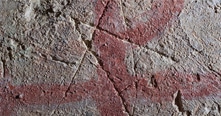
This new paper discusses RTI (Reflectance Transformation Imaging) for documenting historical graffiti in Catacombs. Historical graffiti provide unique information on the uses of the catacombs over the centuries. Some of the graffiti of the catacombs of San Giovanni are contemporary with the epoch of the paintings that bear them (late antiquity), while others have been incised by pilgrims in the Early Middle Ages. The graffiti constitute significant documentation of the late-antiquity and medieval Christian history of the catacombs and the use of innovative technologies to enhance their readability is necessary.
“Innovative Imaging Techniques for Examination and Documentation of mural paintings and historical graffiti in the catacombs of San Giovanni, Syracuse” shows how coupling infrared photography with RTI increases the reading of graffiti incised on wall paintings made with ochre pigments.
RTI documentation was carried out in order to test the capabilities of this method as a tool to enhance the readability of historical graffiti.
RTI is a natural way to document graffiti, since it overcomes the limitation of requiring raking light photography to adequately read them. Infrared light coupled with RTI provides more informative RTI images because some pigments, such as, in this case, ochre, become transparent, and the photos are not disturbed by the paint which has randomly detached from the mural. This study used a custom made Arduino distance meter to solve the issue of moving the strobe on a pole around the graffiti while keeping constant distance.
The Catacombs of Syracuse have been one of CHSOS field projects since 2013 and have been part of CHSOS Training programs.
This research was pursued in collaboration with University of California San Diego, CISA3, which sent their PhD student Samantha Stout to run X-ray Fluorescence spectroscopy examination of the pigments on the wall paintings (more here).
This work was possible thanks to Elisa Bonacini, archaeologist and innovative technologies for museums expert, which made the connections possible and Prof. M. Sgarlata from University of Catania for allowing us to pursue this research in her capacity as superintendent for the Pontificia Commissione di Archeologia Sacra per le catacombe della Sicilia Orientale.
RTI (Reflectance Transformation Imaging)
[iframe width=”80%” height=”480″ src=”http://www.antoninocosentino.it/webViewer/viewer1.html”]
We use WebGLRTI Viewer developed by G. Palma, Visual Computing Laboratory – ISTI – CNR
3D Photomodeling
Catacomb Syracuse
by antonino
on Sketchfab










